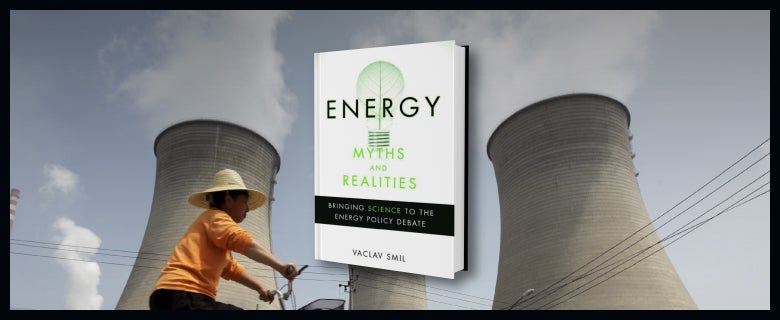How would you describe 2018? Was it what you expected?
I have read a number of books this year by Vaclav Smil, a prolific author and professor at the University of Manitoba who has conducted interdisciplinary research on energy, the environment, population, food production and other important topics. Energy Myths and Realities: Bringing Science to the Energy Policy Debate, examines the various predictions that have been made in the past and are still being made about energy use. Most of these predictions are overly optimistic about how quickly things can change and about the effectiveness of particular approaches. Although Smil remains hopeful in the long run, he clearly thinks we will do a better job if we are realistic about the challenges we face.
My favorite Smil book, Creating the Twentieth Century (and its companion, Transforming the Twentieth Century) chronicles the inventions of the last 150 years. It is quite positive because it focuses on innovation and how innovation has advanced society.
Energy Myths and Realities has a more somber tone because it chronicles so many instances of naïve predictions. (Underscoring this point, the book includes a front piece quoting Publius Terentius Afer, a playright in the ancient Roman Republic, who said: “Men believe what they want to believe.”) Some readers may find Smil’s unrelenting criticism of these misguided thoughts a bit tough, but it is important for us to study these mistakes. If we think solving energy problems is easy we will not invest enough to bring low cost power to the poor and we will not take the necessary actions to avoid climate disaster.
I recommend this book to everyone who spends time working on energy issues, not to cheer them up but to help them have a stronger framework for evaluating energy promises. Smil is able to prove that even if we do our best and innovation is amazing, real change will still take at least 20 years. To me, the long lead times and uncertainties involved in bringing new sources of energy online underscore the importance of pursuing many different paths.
Smil brings a strong historical perspective in his books. It is fascinating that in the early 1900s, many observers thought the internal combustion engine would lose out to steam powered cars or electric cars. However, the economics of gasoline with its high energy density and the difficulty of making cheap batteries helped it win out. Rudolf Diesel, who invented the Diesel engine during the 1890s, actually committed suicide in 1913 because he didn’t think his invention would be successful. In fact, it went on to dominate the large marine and truck market within four decades after his death and much later (by the 1990s) it took a significant share of the European automotive market.
I agree with Smil that nuclear-powered electricity may have a significant role to play in the future. (I’m involved in a company—TerraPower—that is working on a type of a fast reactor we expect will have good economics.) But there are many challenges that must be addressed with nuclear around cost, safety, security of materials, and waste disposal. Although I believe there’s a good possibility that innovation can address these issues, we shouldn’t pursue this option alone.
Smil is appropriately tough on the ethanol crowd. This is one energy approach that is unlikely to ever have a significant impact due to fundamental problems. The fact that the U.S. has subsidized this activity at a cost of $5 billion to $7 billion per year—even as it raises the cost of food—is incredible. The U.S. won’t allow foreign ethanol to get the same tax credit, which suggests that the policy is not really focused on the energy benefits of ethanol. A large lobby, which now extends even beyond the corn farmers, manages to keep the policy intact. There are some biofuels approaches that might be better, but even with those there are lots of problems to be solved.
In his other books, Smil opened my eyes to the challenges of many of the new energy technologies by showing their limited energy density. If you compare renewable energy technologies with current power plants fueled by fossil fuels, they are 10 to 100 times less power-dense. This doesn’t mean renewables won’t succeed, but there are a lot of variables to consider, such as weather conditions that affect the predictability of energy generation and the lifespan of equipment.
Smil does a great job explaining why sequestering a large percentage of CO2 emissions won’t ever be easy and is certainly not achievable at large scale in the next several decades. There will be more than 500 billion tons of CO2 generated between 2010 and 2025. This is over 10,000 times more volume than is available in the current experimental carbon sequestration storage projects.
The long term storage challenge will likely require governments to assume responsibility for monitoring and liability. Until a government shows a willingness to do this, I don’t think private industry should risk a lot of money on an effort along these lines. This is a case where the difficulties are understated partly because anyone who has a stake in hydrocarbons may be biased towards this solution since it seems to preserve their current investments, or at least delay any substitution.
Smil is tough on the Gore view that a transition was possible within a 10 year period. He is also very tough on two Scientific American articles that made it seem like it was going to be very easy to switch to renewable sources. I agree with Smil that this thinking erodes the willingness of the public to allow a carbon tax of some kind to be put in place or to fund more basic research and development, which I think is important. I am part of a group called the American Energy Innovation Council that has recommended more government spending on R&D to go along with strong carbon reduction policies.
Smil is careful to point out that energy technologies can’t advance at the rate that microprocessor chips have over the last several decades. To see how different the energy world is from chips and computers, one only need look at the limited improvements in batteries and various types of engines. When people look at the true cost of solar, the challenges of installation and bad weather in the field are often ignored. Smil does a good job of explaining how the figures used for renewable energy installations report peak power output, so you have to divide that by the fraction of the day the energy is available to compare it to plants like nuclear plants that are available over 90% of the time. Because renewables are intermittent, you have to have either a backup way of generating the power and have fully funded that, or you have to have a large scale storage solution which has not been invented and may not be for several decades.
Although Smil focuses mostly on predictions in the energy sector that erred on engineering and cost, we also have to get the regulations and incentives right. It is very difficult to design the right incentives for reliability, transmission, storage and waste. The example of Yucca mountain where the U.S. government promised to solve the nuclear waste problem, spent $9 billion and then cancelled the projects seemingly for political reasons, is concerning. Likewise, it is instructive that the way that the California electricity market was “deregulated” in order to reduce electricity prices actually led to huge price increases. Energy networks involving renewable sources are far more complex than today’s energy networks and any piece that is not handled well leads to a loss of power.
Smil points out that not all projections for the future are overly optimistic. Sometimes a new development like shale gas (natural gas in coal shale formations) comes along and surprises people on the upside. I’m also encouraged by the fact that more engineers and entrepreneurs are working on energy solutions all over the globe than at any time in the past, and they are empowered with better scientific understanding, better modeling tools, and by the ability to share information with each other. Of course, even these positive surprises take decades before they make a difference because of the gigantic scale of the global energy economy.
I don’t view Energy Myths and Realities as a doom and gloom book. It is sobering about the mistakes that have been made but Smil ends by listing a number of lessons that come out of the mistaken predictions of the past, all of which I agree with. I think this book will contribute to better energy policies, which is critically important.





